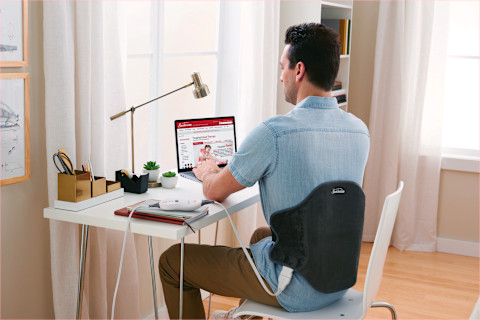The Science Behind Why Heat Feels SO Good For Pain

Few things are more comforting than unwinding with a warm bath or getting under the heated covers on a heated massage table. Emanating warmth on our bodies feels good—no doubt about that—but did you know that heat in these instances is way more than just a soothing sensation?
There’s a word for applying heat to parts of the body to help alleviate pain, stress, and stiffness in muscles and joints: It’s called thermotherapy, or heat therapy, and humans have been turning to it for pain relief for centuries. The heating pad you used for cramps is a perfect example of it.
What type of pain or discomfort can heat therapy help?
Targeted heat therapy is a natural, relaxing treatment for non-inflammatory body pain, like dull or persistent pain associated with stiffness and cramping.
Think: Relief from lower back pain or neck spasms; muscle soreness after a tough workout, a 5k PR, or the first ski trip of the season; tightness or “knots” in your shoulders and upper back from hunching over your computer; restless leg syndrome; and menstrual cramps. And according to science, it’s doing more than just relieving symptoms at the surface.

How does heat therapy work, exactly?
On contact, a surge of warmth—whether it’s a dry heat (like your heating pad) or a moist heat (like your bath)—has been clinically shown to help reduce pain1 by opening up blood vessels and increasing blood flow, oxygen, and nutrients to muscles and joints.
When you apply a heat wrap or other accessory to your muscles or joints, the heat is hard at work doing several things:
- The heating effect on the skin or soft tissue increases blood flow to the area by vasodilatation, which in turn increases tissue elasticity and reduces muscle tension and tightness.
- Increased blood flow also brings more oxygen and nutrients to the painful or sore area, speeding up the metabolic rate in the tissues (in other words, more energy to repair damage) and in turn, promoting recovery.
The cool part? It’s not just hot water bottles encased in crocheted covers anymore: The space has innovated and evolved through the years to meet more needs. Sunbeam, a trusted name in heat therapy (for over 100 years, in fact), specializes in targeted heat therapy accessories for nearly every kind of relief your body is craving. One of its newest innovations is the super-soft electric Heated Back Wrap, which is contoured for a snug, hands-free fit—like a heated blanket designed to hug your tense lower back muscles, only much better. It has four heat-level settings that shut off automatically after two hours (for peace of mind). Another is Sunbeam’s GoHeat™️ Portable Heated Patches, which are great for relief on the go, anytime, anywhere—as well as for anyone who wants super customizable options for targeted heat therapy (because we all have that one side that holds a little more stress than the other).

What else should we know about heat therapy?
When you think about it, you’re likely already applying the idea of heat therapy into other aspects of your life. You warm up cold muscles before a run or nearly any kind of workout. You sign up for a hot yoga class to deepen your stretches and increase your flexibility and range of motion (and yes—research has shown2 that people are more flexible after eight weeks hot yoga).
Ultimately, it’s not just about pain relief. A crop of emerging scientific studies continues to carve out a need for us to better understand heat therapy and all the ways it impacts our well-being—even our relationships and social interactions. One fascinating study, for instance, found that people who held a cup of hot coffee (vs. iced) perceived others around them as trustworthy and caring—literally promoting interpersonal warmth. Another study showed that people who experience ongoing loneliness or social exclusion felt comforted by a physically warming experience, like a bath.
Clearly, the scientific and wellness communities are paying more attention to opportunities for all new kinds of heat therapy. It’s a new chapter for a time-tested practice, and it’s just only heating up.
